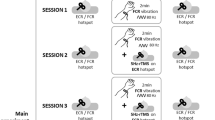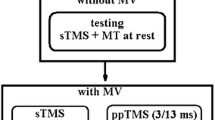Abstract
The aim of the present study was to investigate the effects of muscle tendon vibration at different frequencies on corticospinal excitability by means of transcranial magnetic stimulation (TMS). A second objective was to describe whether the observed modulations in motor evoked potentials (MEPs), as a function of vibration frequency, reflect the behavior of Ia afferents during and after vibration. In ten subjects, muscle tendon vibration (duration 30 s) was applied to the flexor carpi radialis (FCR) muscle at three different frequencies (20, 75 and 120 Hz). MEPs following single-pulse TMS were recorded from the targeted muscle during a previbration, vibration, and postvibration period. Muscle tendon vibration at 75 Hz increased the MEP amplitude significantly during vibration, whereas a smaller but still significant effect was observed during 120 Hz vibration. No significant MEP changes could be observed during 20 Hz vibration and during the postvibration period for each frequency. Our findings indicate that muscle tendon vibration exerts a frequency-dependent effect on corticospinal excitability. Furthermore, evidence is provided for the notion that the excitatory effect of muscle tendon vibration on the primary motor cortex is mediated by Ia afferent input.



Similar content being viewed by others
References
Abbruzzese M, Minatel C, Reni L, Favale E (2001) Postvibration depression of the H-reflex as a result of a dual mechanism: an experimental study in humans. J Clin Neurophysiol 18:460–470
Caria MA, Kaneko T, Kimura A, Asanuma H (1997) Functional organization of the projection from area 2 to area 4gamma in the cat. J Neurophysiol 77:3107–3114
Carson RG, Riek S (2000) Musculo-skeletal constraints on corticospinal input to upper limb motoneurones during coordinated movements. Hum Mov Sci 19:451–474
Carson RG, Riek S, Bawa P (1999) Electromyographic activity, H-reflex modulation and corticospinal input to forearm motoneurones during active and passive rhythmic movements. Hum Mov Sci 18:307–343
Colebatch JG, Sayer RJ, Porter R, White OB (1990) Responses of monkey precentral neurones to passive movements and phasic muscle stretch: relevance to man. Electroencephalogr Clin Neurophysiol 75:44–55
Cordo P, Gandevia SC, Hales JP, Burke D, Laird G (1993) Force and displacement-controlled tendon vibration in humans. Electroencephalogr Clin Neurophysiol 89:45–53
Day BL, Thompson PD, Dick JP, Nakashima K, Marsden CD (1987) Different sites of action of electrical and magnetic stimulation of the human brain. Neurosci Lett 75:101–106
Edin BB (1990) Finger joint movement sensitivity of non-cutaneous mechanoreceptor afferents in the human radial nerve. Exp Brain Res 82:417–422
Eklund G, Hagbarth KE (1966) Normal variability of tonic vibration reflexes in man. Exp Neurol 16:80–92
Evarts EV (1973) Motor cortex reflexes associated with learned movement. Science 179:501–503
Evarts EV, Tanji J (1976) Reflex and intended responses in motor cortex pyramidal tract neurones of monkey. J Neurophysiol 39:1069–1080
Fetz EE, Baker MA (1969) Response properties of precentral neurones in awake monkeys. Physiologist 12:223
Fourment A, Chennevelle JM, Belhaj-Saïf A, Maton B (1996) Responses of motor cortical cells to short trains of vibration. Exp Brain Res 111:208–214
Ghosh S, Porter R (1988) Corticocortical synaptic influences on morphologically identified pyramidal neurones in the motor cortex of the monkey. J Physiol 400:617–629
Ghosh S, Brinkman C, Porter RA (1987) A quantitative study of the distribution of neurons projecting to the precentral motor cortex in the monkey (M. fascicularis). J Comp Neurol 259:424–444
Hagbarth KE (1973) The effects of muscle vibration in normal man and in patients with motor disorders. In: Desmedt JE (ed) New developments in EMG and clinical neurophysiology, vol 3. Karger, Basel, pp 428–443
Hagbarth KE, Eklund G (1966) Tonic vibration reflexes (TVR) in spasticity. Brain Res 2:201–203
Huerta MF, Pons TP (1990) Primary motor cortex receives input from area 3 in macaque. Brain Res 537:367–371
Jennum P, Winkel H, Fuglsang-Frederiksen A (1995) Repetitive magnetic stimulation and motor evoked potentials. Electroencephalogr Clin Neurophysiol 97:96–101
Jones EG, Porter R (1980) What is area 3a? Brain Res Rev 2:1–43
Kossev A, Siggelkow S, Schubert M, Wohlfahrt K, Dengler R (1999) Muscle vibration: different effects on transcranial magnetic and electrical stimulation. Muscle Nerve 22:946–948
Landgren S, Silfvenius H (1969) Projection to cerebral cortex of group I muscle afferents from the cat's hind limb. J Physiol (Lond) 200:353–372
Landgren S, Silfvenius H, Wolsk D (1967) Somato-sensory paths to the second cortical projection area of the group I muscle afferents. J Physiol (Lond) 191:543–559
Lemon RN, Porter R (1976) Afferent input to movement-related precentral neurones in conscious monkeys. Proc R Soc Lond B Biol Sci 194:313–339
Lewis GN, Byblow WD (2001) Repetitive proprioceptive stimulation alters corticomotor representation. Poster presented at the International Symposium on Movement and Sensation, September 3–6, Cairns, Australia
Lewis GN, Byblow WD, Carson RG (2001) Phasic modulation of corticomotor excitability during passive movement of the upper limb: effects of movement frequency and muscle specificity. Brain Res 900:282–294
Lucier GE, Rüegg DC, Wiesendanger MP (1975) Responses of neurones in motor cortex and in area 3a to controlled stretches of forelimb muscles in Cebus monkeys. J Physiol (Lond) 251:833–853
Matthews PB, Stein RB (1969) The sensitivity of muscle spindle afferents to small sinusoidal changes of length. J Physiol 200:723–743
Münte TF, Jöbges ME, Wieringa BM, Klein S, Schubert M, Sönke J, Dengler R (1996) Human evoked potentials to long duration vibratory stimuli: role of muscle afferents. Neurosci Lett 216:163–166
Murphy JT, Won YC, Kwan HC (1974) Afferent—efferent linkages in motor cortex for single forelimb muscles. J Neurophysiol 38:990–1014
Naito E, Ehrsson HH, Geyer S, Zilles K, Roland PE (1999) Illusory arm movements activate cortical motor areas: a positron emission tomography study. J Neurosci 19:6134–6144
Nordin M, Hagbarth KE (1996) Effects of preceding movements and contractions on the tonic vibration reflex of human finger extensor muscles. Acta Physiol Scand 156:435–440
Oldfield RC (1971) The assessment and analysis of handedness: the Edinburgh inventory. Neuropsychologia 9:97–113
Pascual-Leone A, Tormos JM, Keenan J, Tarazona F, Canete C, Catala MD (1998) Study and modulation of human cortical excitability with transcranial magnetic stimulation. J Clin Neurophysiol 15:333–343
Picard N, Smith AM (1992) Primary motor cortical responses to perturbations of prehension in the monkey. J Neurophysiol 68:1882–1894
Radovanovic S, Korotkov A, Ljubisavljevic M, Lyskov E, Thunberg J, Kataeva G, Danko S, Roudas M, Pakhomov S, Medvedev S, Johansson H (2002) Comparison of brain activity during different types of proprioceptive inputs: a positron emission tomography study. Exp Brain Res 143:276–285
Ribot-Ciscar E, Rossi-Durand C, Roll JP (1998) Muscle spindle activity following muscle tendon vibration in man. Neurosci Lett 258:147–150
Ridding MC, Taylor JL (2001) Mechanisms of motor-evoked potential facilitation following prolonged dual peripheral and central stimulation in humans. J Physiol 537:623–631
Roll JP, Vedel JP (1982) Kinaesthetic role of muscle afferents in man, studied by tendon vibration and microneurography. Exp Brain Res 47:177–190
Roll JP, Gilhodes JC, Tardy-Gervet MF (1980) Effets perceptifs et moteurs des vibrations musculaires chez l'homme normal: mise en evidence d'une reponse des muscles antagonistes. Arch Ital Biol 118:51–71
Roll JP, Vedel JP, Ribot E (1989) Alteration of proprioceptive messages induced by tendon vibration in man: a microneurographic study. Exp Brain Res 76:213–222
Rothwell JC (1997) Techniques and mechanisms of action of transcranial stimulation of the human motor cortex. J Neurosci Methods 74:113–122
Siggelkow S, Kossev A, Schubert M, Kappels HH, Wolf W, Dengler R (1999) Modulation of motor evoked potentials by muscle vibration: the role of vibration frequency. Muscle Nerve 22:1544–1548
Stefan K, Kunesch E, Cohen LG, Benecke R, Classen J (2000) Induction of plasticity in the human motor cortex by paired associative stimulation. Brain 123:572–584
Wassermann EM (1998) Risk and safety of repetitive transcranial magnetic stimulation: report and suggested guidelines from the International Workshop on the Safety of Repetitive Transcranial Magnetic Stimulation, June 5–7, 1996. Electroencephalogr Clin Neurophysiol 108:1–16
Weiller C, Jueptner M, Fellows S, Rijntjes M, Leonhardt G, Kiebel S, Muller S, Diener HC, Thilmann AF (1996) Brain representation of active and passive movements. Neuroimage 4:105–110
Werhahn KJ, Fong JK, Meyer BU, Priori A, Rothwell JC, Day BL, Thompson PD (1994) The effect of magnetic coil orientation on the latency of surface EMG and single motor unit responses in the first dorsal interosseous muscle. Electroencephalogr Clin Neurophysiol 93:138–146
Zarzecki P, Shinoda Y, Asanuma H (1978) Projection from area 3a to the motor cortex by neurons activated from group I muscle afferents. Exp Brain Res 33:269–282
Acknowledgements.
Support for the present study was provided through a grant from the Research Council of K.U. Leuven, Belgium (contract OT/99/39), and the Flanders Fund for Scientific Research (Project G.0285.98). The authors wish to thank M. Beirinckx and P. Meugens for technical support, M. Vermeulen for help with data acquisition and analysis, and Dr. J. Rothwell from the Sobell Department of Neurophysiology for helpful comments on the present data. O. Levin is supported by a fellowship from the Research Council of K.U. Leuven (contract F/99/113). S.M. Verschueren is Postdoctoral Fellow of the Fund for Scientific Research, Flanders, Belgium. M. Steyvers is a Research Associate of the Fund for Scientific Research, Flanders, Belgium.
Author information
Authors and Affiliations
Corresponding author
Rights and permissions
About this article
Cite this article
Steyvers, M., Levin, O., Verschueren, S.M. et al. Frequency-dependent effects of muscle tendon vibration on corticospinal excitability: a TMS study. Exp Brain Res 151, 9–14 (2003). https://doi.org/10.1007/s00221-003-1427-3
Received:
Accepted:
Published:
Issue Date:
DOI: https://doi.org/10.1007/s00221-003-1427-3




